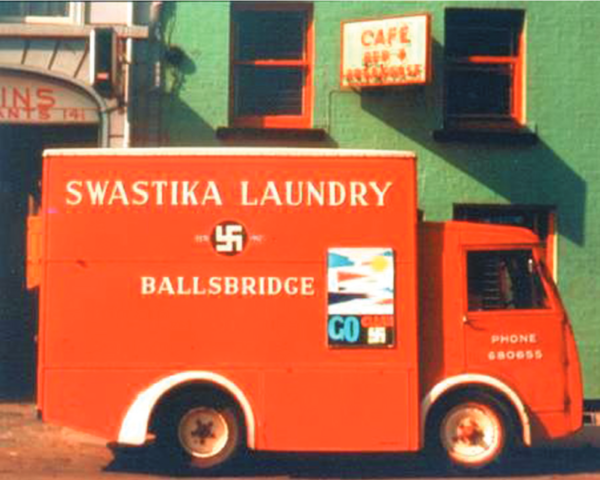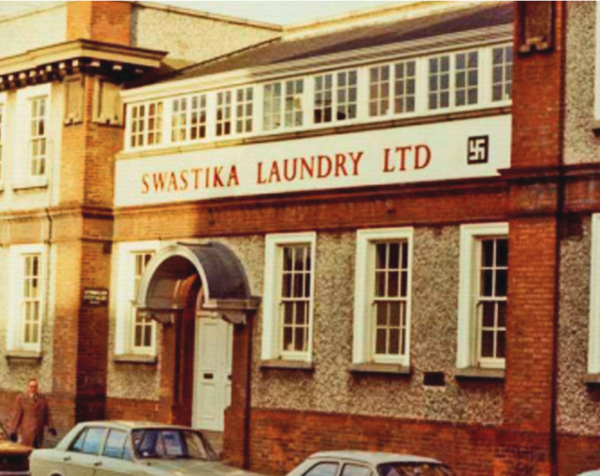
Eoin Meegan
Much has changed around Ballsbridge over the last century, as in many other parts of the capital. One big change is the disappearance forever of a one-time iconic building and industry, the Swastika Laundry.
Operating for over 70 years, it had become synonymous with the area, providing a much-needed service and employment too. Standing on a three-acre site not far from where the Aviva is now, its rust-coloured chimney stack, emblazoned with the swastika, was a familiar landmark for all to see.
The company was started in 1912 by John W. Brittain. Brittain a native of Manorhamilton, in Co. Leitrim had already established the Metropolitan and White Heather Laundries prior to setting up the Swastika.
The story goes that while attending the great industrial exhibition of 1910 in London, he came across an ornament bearing the swastika and immediately fell in love with it. From that moment he made up his mind it was to be the name of his newest company.
Following his death in 1937 the company was taken over by his son E. A. Brittain, who proceeded to modernise it and mainstream the workforce. He also acquired smaller laundries such as Bells, Dyers and Cleaners, and Dunlop’s Laundry, incorporating them into the Swastika empire. The laundry boasted of the purity of its cleaning process, and promised that no pollutant such as bleaching powder or caustic soda was used.

Laundry was a thriving industry back then, the Swastika being just one of many in the capital. We have to think of an era before the washing machine had become a common household appliance, and people were less self-sufficient. Not only did businesses, hotels, hospitals and such like avail of laundry services, many private residences and households did too. Wealthy people would often have the laundry ‘sent out’ rather than go to the trouble of having it done at home.
Why the ‘Swastika’?
We might find it strange now that a company would call itself ‘swastika’, and display the image, which is now universally recognised as a badge of hate and oppression. However, all things must be seen in context, and the Swastika laundry, which we saw was founded in 1912, pre-empted Hitler’s Nazi Party and its appropriation of this very ancient and important symbol by almost a decade.
In fact, in the early 20th century it was considered fashionable for manufacturers to bear the swastika in their logo, probably because of its association with prosperity and good luck. The Carlsberg Brewing Company in Denmark did so, as did, among others, the Finnish Air Force.
By the mid-1930s though its use and symbolism had been completely subverted, and it was quietly dropped as a signage by all leading firms. However, for the Dublin Laundry this wasn’t so straightforward as it wasn’t just their logo, but their name as well, and so any change would necessitate a whole new rebrand. The company cleverly side-stepped this by a change of name, when in 1939 it became The Swastika Laundry (1912), thus clearly distinguishing itself from the German Nazi Party, while still retaining the emblem.The swastika used by the Dublin Swastika Laundry is also shaped differently from the better-known fascist one, displaying a white swastika on a black roundel, rather than the other way round.
The swastika had long been considered a symbol of good luck and prosperity. There are two designs, a right facing one, which was meant to represent the sun and the masculine order, and a left facing one, suggesting the unconscious. In India, where it had long been revered, the latter evoked aspects of Kali, the Hindu goddess of Tantra, and for eons had been considered an emblem of good luck.
The Buddhist swastika represented eternity and reincarnation. The symbol has been found in ancient religious iconography right across the Indian subcontinent, Eurasia, and the Americas; even turning up in some Palaeolitic sites.
To the Navajo of Arizona and New Mexico it stood for healing and well-being, while other Native American tribes used it to adorn jewelry and personal belongings. The Aztecs had their own version of it, and the swastika also appeared on Ogham stones here in Ireland. Unfortunately, the symbol has now lost much of its lustre and will most likely be forever associated with anti-semitism, and the worst aspects of humanity.
Electric vehicles in Dublin
In a time when electric vehicles are seen as the way of the future, it may surprise some to learn that the Swastika Laundry vans which were used to ferry laundry to and from customers back then were all electrically operated. The motive, of course, was undoubtedly economic rather than any conscious environmental one.
The vehicles employed two electro-magnets with a pivot, and a battery that was charged nightly. These distinctive red vans could be seen maneuvering their way between trams and busy traffic, and were probably as common a sight to Dubliners then as the 46a bus is today.
Following the invention of the lead-acid battery in 1859 and the rechargeable battery, electrically powered vehicles were commonly used from the mid-to-late 19th century. Their drawback was that they were expensive to operate and did not produce high speeds, and thus were mainly confined to cities. They be-came popular for local deliveries, bread vans and milk floats. With the advance of the internal combustion engine, the electric motor gradually became obsolete.
The Swastika Laundry continued in existence until well into the 1960s, when it was taken over by the Spring Grove Laundry. This company continued to operate it as the Swastika Laundry until its eventual decline and closure some 20 years later in1987.
Today all that is left of the famous laundry is the chimney, a preserved structure, although its controversial emblem has long since disappeared. A new office complex known as the Oval has grown up around it, and visitors can stroll down the avenue off Shelbourne Road and see the chimney for themselves. It overlooks the Dodder, alive with pigeons, ducks, swans, and the familiar heron on the other side.
The erstwhile laundry holds many fond memories for local people, and while the work was undoubtedly hard, and a 12-hour shift was not unheard of, it was considered a good source of employment for young women in the Ringsend and Ballsbridge areas, employing around 600 in 1960, and for its time the wages were considered good.
Along with Bolands, Johnson Mooney and O’Brien, and Irish Glass Bottle, it was one of the mainstays of employment in the area. Like many other good things – and some not so good – it is now consigned to become a distant memory of things that once were.



